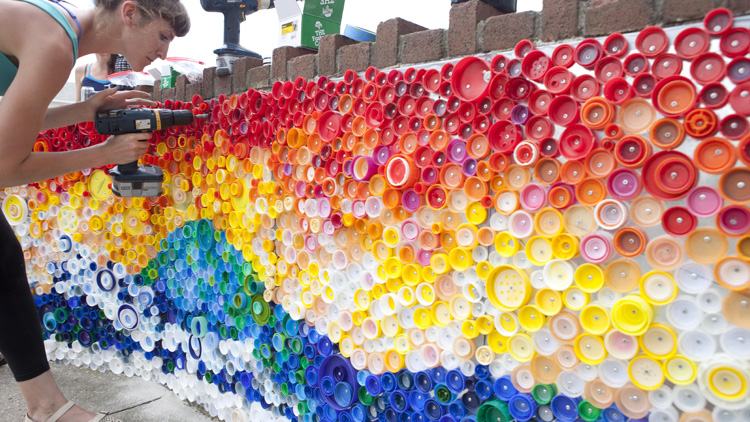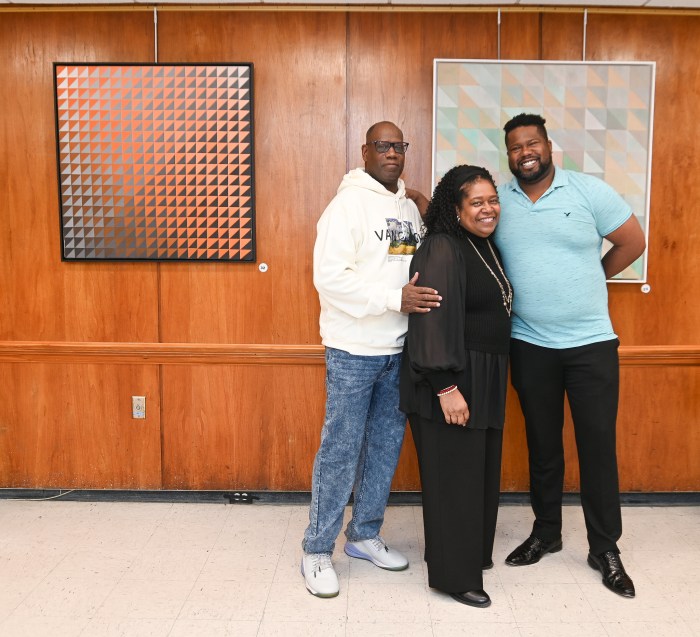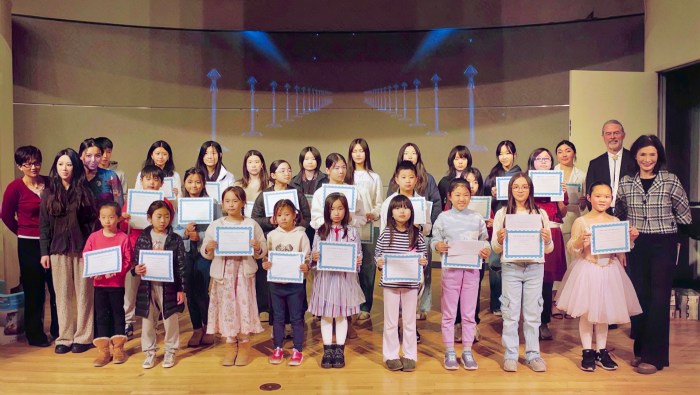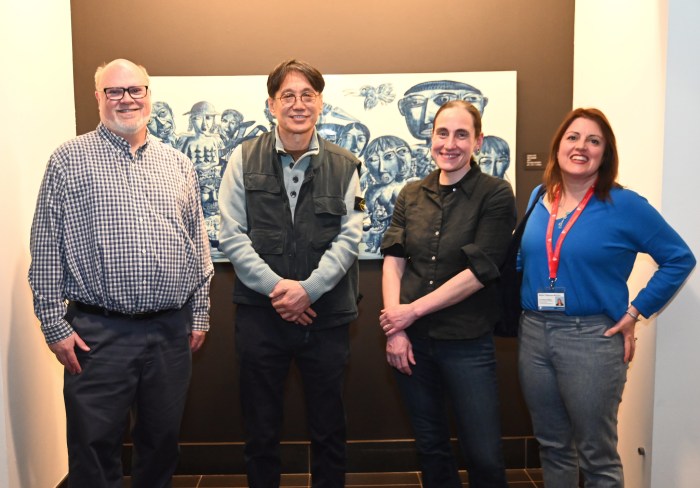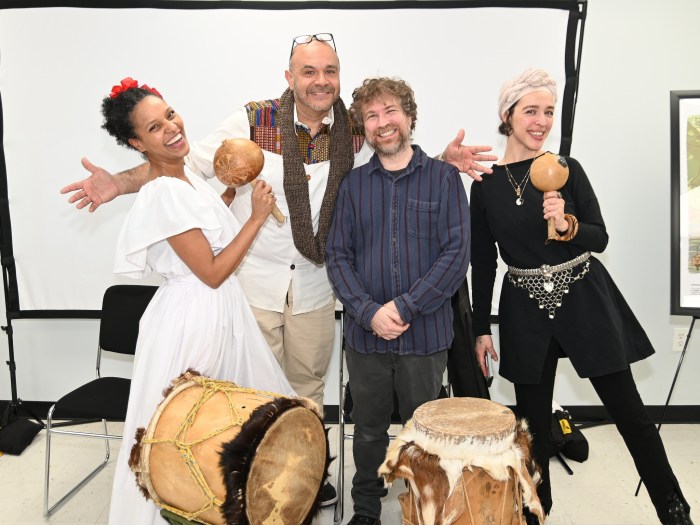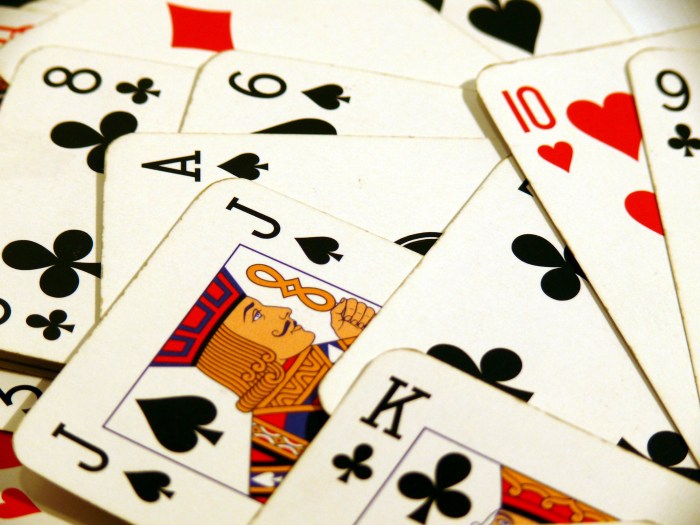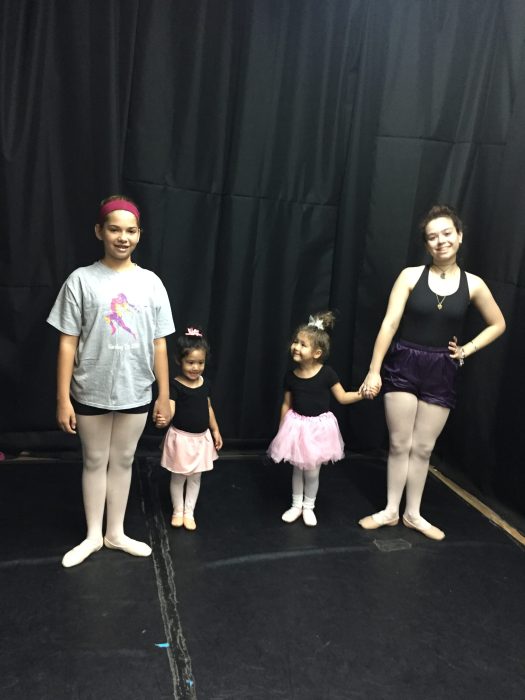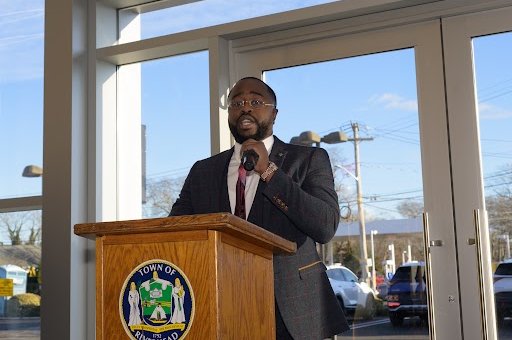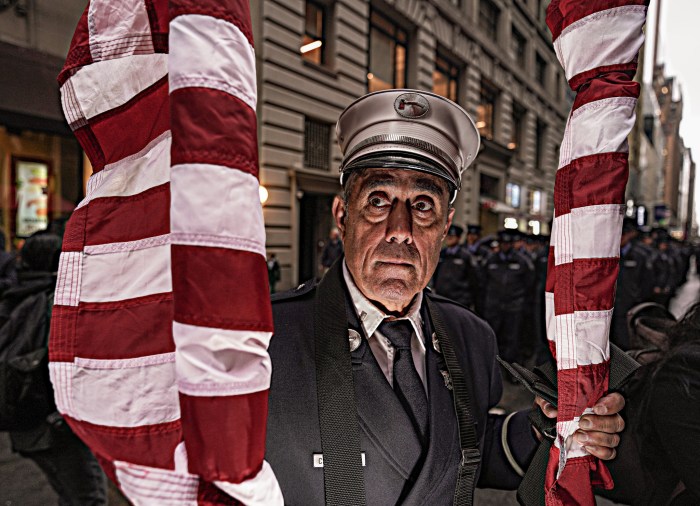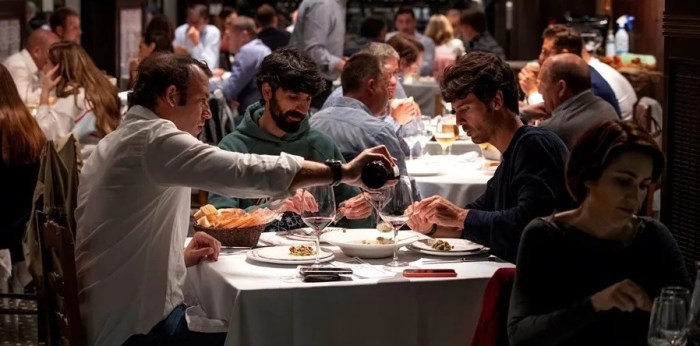A battered tree sprouts from the cold tiles in the center of a brightly lit room.
Some of its branches stretch out across the ceiling, tousled in gold and silver fabric, while others lie broken and warped, littering the floor alongside a barrage of wreckage strewn beneath the distorted arch. Tangled green and red wires dangle from its lofty fingers, spilling out onto the floor, where yellow caution tape and orange cones become lost amongst the chaos. A barricade stands shattered atop the clutter, sending a warning to all who walk by of its potential danger.
Poet Steven T. Licardi stands before an anxious crowd circled around him, searching for his spot in the pages of a book. He leans into a microphone. With clenched fists and closed eyes he passionately and enthusiastically casts a spell, mesmerizing all reciting, imploring:
“Apocalyptic sermons filled the spaces between kin and kinsmen, stories of survival told over dancing candlelight. The wind had aided the trees in exacting their revenge, taking men in their driveways in front of their families! But it was peacetime.”
His eyes open suddenly and shoot piercing daggers into those of the audience, while continuing his incantation.
“Splinters of barky skin and limbs peppered the crooks of our community. In spite of all the horror,” his voice gets louder, “Halloween was canceled.”
Studio 5404 sits alongside Merrick Road in Massapequa, surrounded by the South Shore town’s many local businesses and restaurants. Only feet away from its powdery blue and bright red doors is where Superstorm Sandy wreaked havoc nearly a year ago, leaving homes destroyed and lives turned upside-down.
Yet it is here that artists such as Licardi unleash their own fury, bending and twisting the emotional carnage left behind by Mother Nature into something raw, something visceral, something tragically beautiful, something magical. “A Brush With Sandy,” as the exhibit is titled, is replete with powerful photographs, paintings, sculptures, and poetry borne of the disaster in an effort to not only express the human toll of the storm’s devastation through the arts, but to raise money for those affected by the tragic storm. This exhibit is just one of countless creative projects being wielded across Long Island in response to what has so severely wounded so many. From public art murals to paintings, to photographs, spoken word tributes, songs and documentaries, Sandy’s wrath is alive and well, yet transformed into positive, creative works of pure humanness.
It’s also a great way to open up the hearts and souls of those still suffering, those still reeling, though who do not yet know the healing wonders of art.
“The community understands Sandy; they understand what they went through,” says artist and studio founder Lori Horowitz while greeting a steady stream of visitors. “The community doesn’t necessarily understand the arts, yet. So the idea of bringing people out and raising their consciousness about Sandy and then mixing it with the art and inspiration that come from it will hopefully help the community focus on that.”
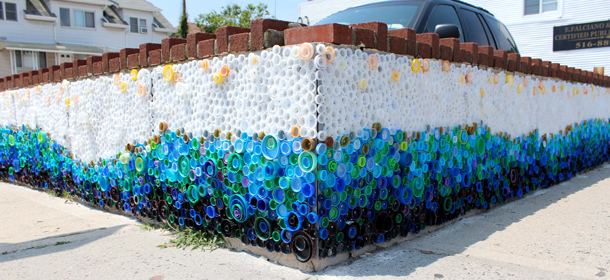
The studio itself acted as a safe haven for some locals.
“We were just opening at the time,” she says with her hand to her heart. “We got hit pretty badly, but we got oil in here, bedding and food, and had people stay here. We really saw the devastation firsthand.”
Nearby, landscape artist and Rockaways native, Michael Schor, is snapping photos of the guests that stop to admire his work.
“It’s beautiful and tragic,” he says, a camera in his hand while gazing at the captivating images. “I got to the head of this block, and realized this mother and her daughter were walking into my shot,” he says pointing at a photo titled “The Silent Walk,” which captures in full horror the brutal destruction that ravaged 119th Street in the Rockaways. “Look how stunning their reflection is in the water. See, when you look at this photo, that is what you tend to focus on,” he says, pointing to the ghostly, haunting reflections of the pair walking through the warzone. “Then you realize [that] only a few feet away, a car is flipped over,” he adds, glancing at a beaten-down navy blue car turned completely upside-down in water on someone’s property.
Schors’ captivating photos of the aftermath have gone viral, and some have been picked up by news agencies all over the world.
“I tried to capture beauty of this craziness from a photo journalistic perspective,” he explains, pointing to another piece, “Rockaway on Fire,” of 116th Street and what was left of Rockaway Beach Boulevard. “There were police signs and stuff, but I needed to get closer to capture this,” he continues. “By the time I realized I was close enough, I started to feel the hair on my arms start to tingle because of the flames. I got out of there!”
A trio of striking paintings further amplify the total decimation of the tragedy from a nearby wall.
“I’m a veterinarian, I own an animal hospital in Merrick, and it was totally destroyed,” says artist Gary Selmonsky. “We had about four feet of water in the place, but it is back now. Lighting, water, and devastation,” he says slowly, pointing to one of his creations. His visions are superimposed atop the hellish backdrop of the aftermath left in the wake of the 2011 Japanese tsunami that literally wiped some communities there off the map. Characters in his works include those shown in the iconic Godzilla movies.
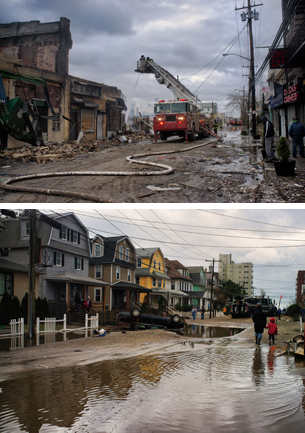
“In the 1950s, 1960s, Japan was scared of all the nuclear experiments going on in the Pacific Islands. One of the reactions of that is they made the Godzilla movies. So when you think about it, it’s sort of like 60 years later, all the horror comes to life.”
Poet John Brennan, of Garden City via Northern Ireland, awaits his chance to recite his creation “The Storm,” inspired by Sandy. He is humbled to have only lost power for 10 days.
“Seanachie,” he says, in soft-spoken brogue. “It means, ‘We are all artists,’ in Gaelic. You see, all artists, no matter what medium, are all gifted. It’s something they are able to tap into. Van Morrison really put it the best. Someone said to him, ‘Jesus, man, how do you write them thousands of songs?’ Van says, ‘I didn’t write them, I tapped into the source.’
“It’s a gift,” Brennan says. “The thing about a gift is, it only works if you give it away, and that’s why I’m here tonight.”
He belongs to The Bards Initiative, a Long Island poetry nonprofit dedicated to using poetry to support the community. The group of poets has done work for causes like breast cancer, autism, and now, the Island’s most recent hurtle, Sandy. They gather here tonight to recite poems from their book, Songs of Sandy, put together by The Bards’ editor, J.P Wagner.
“Songs of Sandy came along as our attempt to have a quick and timely response from the poetry community concerning the disaster and to do our part since our greatest power is our words, and we wanted to do what little we could to raise some money quick for the relief,” says Wagner. “I was without power for only a day, and I spent it writing poems—plenty of which were about the storm. I figured every other writer on the Island must be doing the same thing, so the second I got my power back I called my vice president and co-editor.
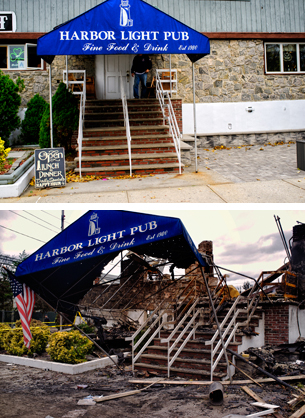
“The book filled up the quickest of any book I ever worked on,” he adds. “We were honestly expecting maybe a chapbook of like 15 to 20 poets to respond, but in two week’s time, nearly 50 poets sent in their work.”
Collaboration is something Bards poet Karen Jakubowski, of Massapequa, knows all about.
“For me it was learning how much people care for one another,” she explains. “My neighborhood became a community. Everyone came together. We shared resources, we helped each other.”
“Sandy was a wake-up call to me,” she adds as she awaits her chance to recite her poem “Why Sandy.” “It came to tell us that you can’t live in a place of greed. If you don’t listen, we are going to take it from you.”
And it’s a collaboration, and an undying commitment to translating the divine inner visions which artists experience as bright as day, which fuel such passionate dedication to bringing these creations into this realm.
Lisa Be, an artist and activist from Long Beach, had her entire apartment submerged beneath 4 feet of seawater when Sandy rammed the barrier island Oct. 29. She eventually became homeless.
“The beach met the bay in my apartment,” she says, over the telephone on a recent afternoon.
The 27-year-old is also the co-founder of nonprofit Project Vortex, an arts initiative aimed at inspiring artists, designers, architects and other creatives to use everyday plastics in their works, thus helping to eliminate their disposals in the ocean and other waterbodies, and protecting these invaluable resources in the process.
So, in the wake of the storm, Be petitioned all the public schools in Long Beach to collect any plastic caps or lids they came about on a daily basis, with the promise of pizza and ice cream for the kids. In one month, she collected a whopping 75,000. She and a handful of other artists drilled 25,000 of them into the walls along West Beech Street and Maryland Avenue.
The result is a sprawling, magnetic, gloriously vibrant rainbow tidal wave engulfing the entire block’s corners. She named the colorful public art installment “When The Beach Met The Bay.”
“So visually speaking, as an artist, I just have this recurring vision of cells or circles coming together and attaching,” she says. “I’ve always kind of had that in my mind and seeing it over the years the connection with bottle caps really came naturally. I never had the motivation or the push to just do it. There was also an excuse in some way and the notion down here, I guess returning after Sandy was, like, I have no control over anything so why not just do it right now, just do it already?
“I really can’t explain it. I was just filled with this fire-like energy after the storm,” she adds. “There’s just no more excuses. No one is going to do anything for me. I have to do it myself, and especially, environmentally.”
Back at Studio 5404, that same burning creative fury is apparent. As the night draws to a close and visitors shuffle out, Lori Horowitz stands alongside the gigantic tree in the middle of the room.
The tree represents the devastated reality of so many communities post-Sandy.
But like it, Be’s mural, and all the evening’s creations, there’s beauty, and perhaps even some inspiration, to be had if these same communities all come together.
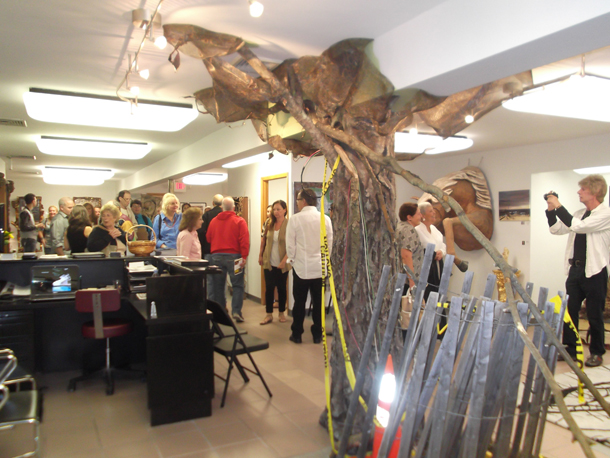
Studio 5404 Art Space/Gallery is located at 5405 Merrick Road, Massapequa. To learn more about the studio/gallery, including upcoming exhibits, click HERE. To learn more about Project Vortex, including future projects and how to volunteer, click HERE.




